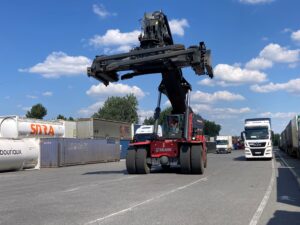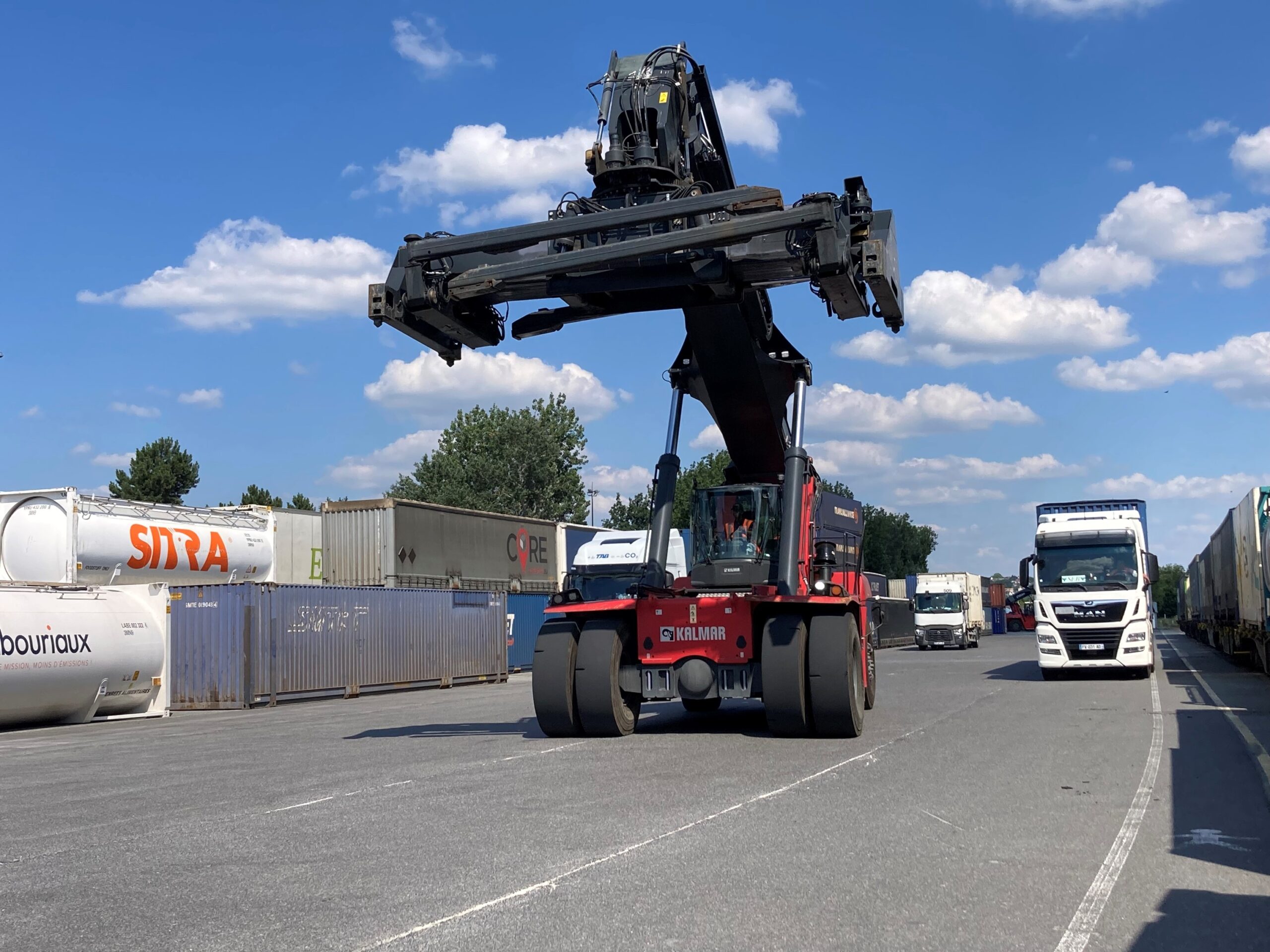PROFESSION LOGISTIQUE N°5 – Summer 2024
 Artificial intelligence isn’t just used to cheat on homework and generate images for social networks. It has a huge range of applications, including logistics. But to what extent? With what objectives and effects? The AI Cargo Foundation was born out of these questions, but also intends to provide some answers. Its chairman Guillaume Desveaux answers our questions.
Artificial intelligence isn’t just used to cheat on homework and generate images for social networks. It has a huge range of applications, including logistics. But to what extent? With what objectives and effects? The AI Cargo Foundation was born out of these questions, but also intends to provide some answers. Its chairman Guillaume Desveaux answers our questions.
 AI Cargo Foundation grew out of the France IA hub. Can you tell us a bit more about how your association came into being?
AI Cargo Foundation grew out of the France IA hub. Can you tell us a bit more about how your association came into being?
The France IA hub, which was set up during Macron’s first five-year term in office, did a lot of work on developing the AI industry. Its mission is really to popularise the industry, and all this led to the launch of calls for projects under the Macron plan for AI. Within this framework, the Hub France IA working group, which brought together major professionals such as La Poste, SNCF, L’Oréal and, of course, AI experts, came to the conclusion that there were many challenges in the transport and logistics sector, and that AI could help these sectors. In particular, it could help them to address the issues of ecological transition and carbon footprint, by exploiting data more effectively. The idea is to make better use of the resources available and to pool them. If we had to sum up the ultimate objective, it would be to provide the industry with a tool. A collaborative tool, in the general interest, to find ways of pooling transport flows. The more we pool, the more efficient we are in terms of energy and carbon footprint. We apply this approach at all levels of logistics. Our raison d’être is to put these technologies to work in the public interest.
Algorithms are as old as computing itself, and we’ve been using them for decades. At what point can we really talk about AI? Is the term sometimes misused?
Yes, these days we tend to use the word AI just about everywhere because it’s fashionable. Nevertheless, it encompasses sciences and mathematics that are distinct from pure computer algorithms. Let’s say there are two main families before generative AI. There is deterministic AI, which is used a lot in transport, and which comes from the branch of mathematics called operational research. Some will say that this is not AI because it does not learn, quite clearly. The system is programmed to achieve an objective set in advance. Nevertheless, we still put them in this family because the volume of data and the complexity of the cases handled bring them closer to the AI family. AI, perhaps in the strictest sense of the term, in the mathematical and computer science sense, really comes into play when the algorithm, the soft ware, has the capacity to make its own discoveries without being given the decision criteria for its choice in advance. It will make a probability. Artificial intelligence is always probabilistic. It will give different results depending on the form of the algorithm, but it’s always probabilistic. It’s the fact that it can itself determine the probability criteria for something that qualifi es an algorithm as AI. After that, as in animal families, there are different kinds, but if we were to reduce it to a species, it would be the self-discovery aspect that would mean it could really be called AI.
How do the members of the association interact with each other? I’m thinking in particular of data sharing and exploitation?
If you’ll allow me, I’m going to divide my answer into two points. First of all, it’s important to talk about governance. We are an association under the law of 1901. We were created under this status because of the very clear question of trust and sovereignty. If you want to pool resources, you have to be able to share data. This data is highly sensitive professional data, so we felt it was essential to create a framework of trust that would enable all the parties involved to be able to enter into this sharing logic. This is the very structure of the association. We are the framework of trust and we operate. We do two things. We design technological solutions that respond to very specific business issues. We operate and develop them. If we look at applications, we work at four levels of scale. The first is long distance. The second is territories and cities. The third is vehicle fleets. And the fourth is common key data indicators, such as carbon footprint measurement. Then, if we take the applied case of data sharing for modal shift , the programme that is driving us the most today, we need the stakeholders, in this case what we call shippers, to share with us the mapping of their transport flows, their transport orders or their transport plans. So they connect to the platform that we make available to the entire industry. They will upload the transport orders for all or part of the flows they have. From there, we will format them to compare them with the flows already integrated. In this way, we can determine what could be combined to make either more trains or barges, or to fill the trains or barges better. The idea is to divert as many lorries as possible to these alternative modes, which consume less energy and emit fewer greenhouse gases.
You have developed a whole series of applications that are available to members. Could you briefl y describe them?
If you don’t mind, I’m going to concentrate on the three most emblematic. As I said, we’re trying to provide solutions at different levels of the flow. Cumulus is the application – financed by a government scheme called Certificats d’Économie d’Énergie – that enables professionals to identify the portion of their flows that can be pooled to make trains or barges. It’s a web-based application that lets them see, in the form of a dashboard or map, the flows that can be pooled, how full the real trains are, and the virtual trains that could be operated. Cumulus is an energy saving application for long-distance services. It has a national and even international focus. Eclimatic, on the other hand, is a cross-functional application that seeks to create a common basis for measuring the carbon footprint of logistics. This is a subject covered by many people, but one where there was a real need for common tools. The application also enables us to pool our resources, so that we have an overview of the fl ows handled by several stakeholders in the same value chain. Finally, the third application: DeliveryPark. It illustrates another aspect of our activities, where we are more interested in decarbonising urban logistics by setting up collaborative working groups with local authorities and professional players. In the vast field of urban logistics, we have identified delivery areas as a rather annoying pain point. They are poorly used; they can be squatted; they are generally not in the right place because trades change, economic activity changes; they are oft en poorly sized in relation to vehicles and needs. And the local authorities know very little about all this. What’s more, it’s very difficult for local authorities to get feedback on who is doing what, and therefore to match public policy with the needs of professionals. As the EPZs are becoming a constraining framework for everyone, private individuals and professionals alike, it was important to find ways of mapping both roads and business activity, with a view to reconciling decarbonisation objectives and the expectations of both. We have therefore developed DeliveryPark, which is both a web and mobile application, and which simply replaces the parking disc with a mobile application. Just as we’re used to with applications for reserving bikes or scooters – when there were any! It’s an extremely easy-to-use application, absolutely free of charge, which enables logistics professionals to identify where a given delivery area is located, and to see whether it’s being used collaboratively. If someone has declared it as being used, it will be mentioned as such. And it will be associated with the vehicle that has been declared in the application. The application makes it very easy to declare a parking space and check that it complies with the regulations: authorised parking time, type of goods and so on. So it works well, it’s very fluid and requires very little effort on the part of the driver and delivery person. The application creates a bridge, a platform for dialogue, and simplifies daily life of the delivery driver.
The aim is not to add constraints, but rather to make life easier. These applications seem to have been well received by professionals, but do some of them still have reservations, for reasons of confi dentiality?
I’m going to give an answer on the two main applications. Firstly, yes, the issue of professional and even personal confidentiality for the driver is very important. And we believe that AI Cargo’s role as a trusted, neutral and sovereign third party is essential to the system. This issue of information sharing is absolutely key. And one of the obstacles to adopting this type of approach was precisely the fact that there was no framework of trust, and the fear of entrusting private individuals or the State with this type of information. So we provide the framework. In terms of modal shift , the Cumulus application now has 133 major companies that have signed up. This is a sign of success and confidence. The initial barrier of reticence has clearly been overcome by the creation of an environment of trust. The second reason why this barrier has been lifted, particularly in terms of the information provided by companies, is the change in attitude. Most companies are now aware of the social stakes that the environment represents. They are aware that they have a role to play and are prepared to rethink their approach as long as they are guaranteed a framework within which to operate. That’s something quite new, because just a few years ago, the idea of pooling data to try and do things better was very much frowned upon, or at least there was a lot of reluctance. Today, the sense of urgency means that people are ready to rethink their vision, their doctrine on this subject. For our part, we try to be as unobtrusive as possible; in fact, we don’t divulge the names of the companies to the territories. We produce summary reports, giving vehicle types, types of goods and so on, but the territories have formally asked us not to give them any information about the companies, no details. We provide aggregate statistical information.
 Last May, there was a trade fair called Drive to Zero, which rewarded your Appel d’AiR programme…
Last May, there was a trade fair called Drive to Zero, which rewarded your Appel d’AiR programme…
That’s right, it’s the programme we run and it accounts for around 70% of our business today. It’s the one that incorporates the Cumulus application, which helps professionals with modal shift and which is formally called a programme because it’s funded by a government scheme such as the Energy Saving Certificates, formalised by a programme agreement.
«these days we tend to use the word AI just about everywhere because it’s fashionable.»
You can imagine that the Olympic Games will be quite a test for logistics professionals. Have you been asked to contribute?
The Ministry of Transport decided to ask us to develop the DeliveryPark application, to off er a suite of digital tools to help professionals manage logistics during the Olympic Games. This soft ware suite is coordinated and piloted by the InTerLUD+ programme and consists of four applications. Two web applications called Visualiz and CirQliz, to start with. Visualiz is a dynamic map that allows transport companies to see on a map all the active and deactivated zones, i.e. the famous red and blue zones during the Olympic Games, as well as all the points of interest such as delivery areas or business addresses. It’s a dynamic map based on French IGN technology. CirQliz is the platform on which professionals are invited to register to declare themselves as professionals. And during the Olympic Games, each day they will have to declare where they must make a delivery, the vehicle that will be used, the location where they will have to act, and in return they will receive a professional QR code, independent of the QR codes managed by the police prefectures. Secondly, Itineriz is a route planner that will help professionals find the best route in terms of traffic restrictions. Finally, the Numeriz application, which will be the driver’s application, is derived from DeliveryPark and will provide drivers with a single application for mapping Paris, the delivery areas and the associated blue and red zones. Drivers will be able to declare their parking once they are in the zone, as this is an obligation that is subject to control. In short, it’s an all-in-one application for drivers, which we hope will make their lives easier during a period that is more restrictive than usual. The aim of these four applications, which have been brought together under the Joptimiz banner, is both to make life easier for professionals during the Olympic Games and to learn from them so that they can be replicated throughout the country, in the various major cities. In other words, what the Ministry calls «the legacy of the Olympics». And we really hope that once the Games are over, these solutions will be redeployed for the benefit of all.
